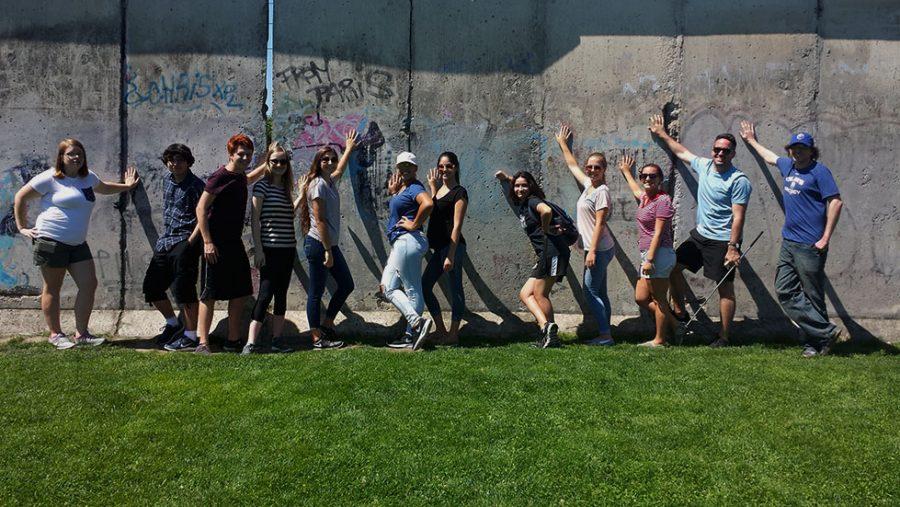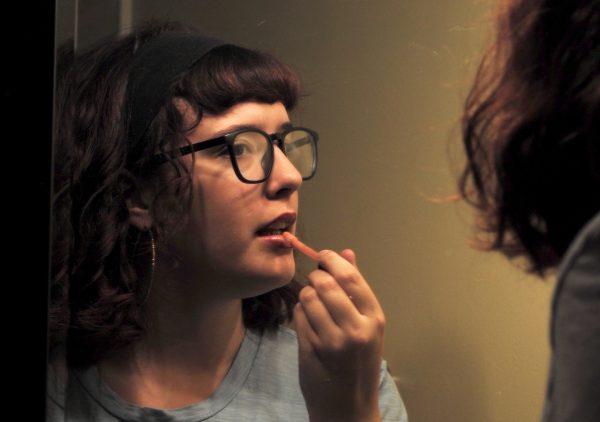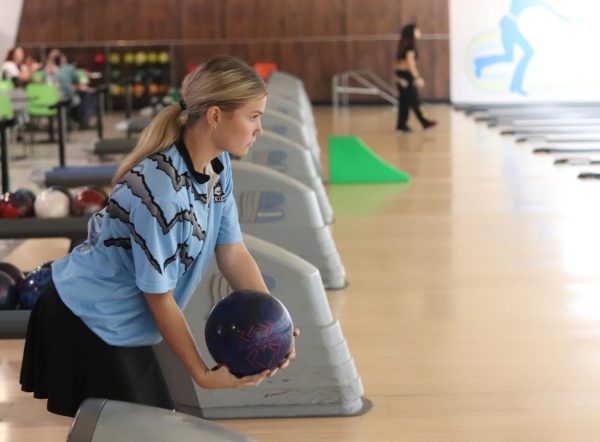Foley flies far
photo by Provided by Erin Foley
The most recent trip, to Eastern Europe, included tours to the Czech Republic, Germany and Poland. While in Berlin, Germany, the group got to visit the Berlin Wall before making the hours-long trip back home.
The weather outside is dry and cold unlike the soupy, moisture-filled air in Florida. Senior James Hynes has a jacket that is wrapped around him loosely and a camera that is ready and waiting for the tour guide to say their group is ready. He is about to walk into the museum that was formally known as the Auschwitz concentration camp. Chills are going up his spine but only one thought is taking over his mind: he is about to witness history in a place where history actually happened.
Hynes is not the only person who gets to experience this. Every other summer, history teacher Erin Foley takes students across the world for a 10-day trip that incorporates the culture, people, food and history of Europe. While the trip can cost up to $4,000, past students have claimed that the trip is “worth every penny.”
Foley has taken students all over Europe, including England, Ireland, France, Belgium, Germany, Poland and the Czech Republic. She says she plans to go to more in the future.
Despite most students’ pleasure of sitting in history class and watching John Green’s crash course videos, Foley’s trips provide a way for a student to not only hear a more insightful description of a historical event, but they also get to hold a piece of history in their hands. Seeing a castle from centuries ago, touching the ruins of a forgotten city and tasting the food of another country awakens a need to learn more—to connect to the people of that place and their history.
“The amount of knowledge and real experience I got from being [in Europe] where actual [history] happened couldn’t possibly fit into a single textbook, let alone one chapter,” former student John McHale said.
McHale and Hynes, among a group of 10 students (not including past students), traveled to Eastern Europe where they experienced Berlin, Warsaw, Krakow and Prague last summer. The trip was mostly WWII-based, but freedom to explore was given very often.
Hynes finds himself reflecting on that trip to this day because of the tours of the concentration camps. He recalls scratches on the walls of the gas chambers and the halls of shoes, clothes, and wedding rings still held in glass cases for the public to see. According to him, those tours are why he is still going on Foley’s trips and still yearning to learn more about history.
This summer, Foley is taking those who are willing to sacrifice 10 days of their summer slumber and Netflix-filled days to go to Italy. Much like her past trips, parents and any students are welcome to go and will be included in all of the excursions as they travel through Rome, Florence and Assisi (the Sorrento Region). Some of the activities include a cooking and painting class in Rome, a gladiator class, authentic Italian cuisine, and visits to prominent historic sites with tours such as Vatican City and the Colosseum. Foley, who claims to never tire of going on these trips, is especially excited for this year’s getaway because the daily trips are fun and different.
“In the first two weeks of being home from [the last trip], I was planning this Italy trip,” Foley said.
The trip, which is found and run by Foley, was actually passed on to her from former department chair Jane Palmer. The trip is taken care of by a company called Educational Tours and it gives each group a tour guide who is fluent in the language, transportation and supervision. The price, which is put in place by the company as well, is determined by the number of people that go on the trip; the more people who go, the more the price goes down. Foley claims that even past students have gone on the trip and are still going on them after graduation. Scott Shaare, who currently attends a law school, has been on three trips since he has left.
The itinerary, chosen by Foley and Educational Tours, is overflowing with activities, shopping, site-seeing and history, but it also has room for group decisions on what to do next. Foley clarified that on later days of the trip, the group will gather at the hotel and discuss what places everyone wants to go to in the free time they have between meals and museums the next day, which makes the trip even more flexible. She also said that she is glad this trip is “not museum-packed,” which will allow for a more interactive way to learn history instead of listening to a tour guide speak for hours.
The classes, which were organized by the travel company, have proven to be extremely fun and interactive. The cooking class involves every person in the group (including parents or chaperones) and puts every participating group against each other in a cooking competition. Similarly, the Gladiator Experience also involves most, if not all, of the members of the group to teach the ways of ancient gladiators and give students the chance to explore the Colosseum where the battles were held. Finally, the art class walks the group through the creation of fresco art, which is seen in many historic buildings in Italy (mostly the ceilings and walls). Once the students have completed their painting, they are able to wrap up their masterpiece and take it on the trip back home.
Each student gets inspiration and a want for learning out of this trip, according to Foley. Somehow the space between people and culture is broadened and the space between continents shrinks, making the history accessible—real.
“When we travel, we only see places that we’ve heard about, whether it’s on TV or in magazines and when you see these places, it activates this part of your brain you didn’t know you had,” Foley said. “The culture and the people and the history of that place makes you want to learn more and more.”
Your donation will support the student journalists of Hagerty High School. We are an ad-free publication, and your contribution helps us publish six issues of the BluePrint and cover our annual website hosting costs. Thank you so much!













